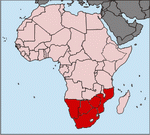History:
The monotypic genus Idiothele was established in 1919 by Dr. John HEWITT (*1855 - †1920) on the base of a male Pterinochilus nigrofulvus POCOCK, 1898. In the same paper HEWITT described also Pterinochilus breyeri (now Augacephalus breyeri), Ceratogyrus brachycephalus and Ceratogyrus dolichocephalus. The habit of the holotype is Barberton in South Afrika.
Dr. Robert J. Raven synonymised the genus in 1985 with Pterinochilus. He assumed that the conical distal segment of posterior spinneret was autapomorphic within Pterinochilus. Richard C. GALLON re-established the genus in 2002 on the grounds that Idiothele differs too much from Pterinochilus. Most important deciding feature was the conical distal segment of posterior spinneret, the weakly-developed plumose scopulae on the prolateral face of the palpal trochanter, the shape of the palpal bulb and the unique behaviour (Note: Idiothele nigrofulva is the only known african Theraphosidae which construct a trap-door to close their burrow.)
GALLON discovered during the research for the revision of the genera Harpactira and Harpactirella that Harpactirella leleupi BENOIT, 1965 is a semiadult male of I. nigrofulva. He synonymised H. leleupi with I. nigrofulva.
The mainarea of circulation is the southern Africa.
Key features of the genus:
-
Distal segment
of posterior spinneret conical (Fig. 95
 )
) - Fovea transverse
- weakly-developed plumose scopulae on the prolateral face of the palpal trochanter
- small scopulae on the chelicerae retrolateral present (s. P. chordatus
 )
) - Scopulae on the chelicerae prolateral absent (s. P. lugardi
 )
) - medium-sized Harpactirinae (female: ~35mm, male: ~30mm)
- Tarsal scopulae undivided (s. P. chordatus
 )
) - Metatarsal scopulae on leg I, II and III undivided (s. P. chordatus
 )
) - Metatarsal scopulae on leg IV bisected longitudinally by band of stiffened setae (s. P. chordatus
 )
) - Spermathecae paired, without terminal lobs (Fig. 59
 )
)
Species:
| Idiothele nigrofulva (POCOCK, 1898) (Type species) | |
 |
Distribution: Botswana, Mozambique, Namibia, South Africa and Zimbabwe Coloration: Legs, palpi and chelicerae uniformly light brown. Leg and palp joints are pale yellow. Carapace brown with yellow radial striae. Dark "mask" around ocular tubercle. Dorsum of abdomen with dark pattern of bars, spots and reticulations. Venter of abdomen uniformly dark brown contrasting with paler lateral dorsal coloration (Fig. 83 Fovea: transverse Spermathecae: triangular (Figs. 93 Palpal bulb: pyriform, variable. Embolus flattened, curved, with two keels (prolateral superior and prolateral inferior) along its length; prolateral inferior keel forming variably sized, transparent, flange. Most specimens with embolus terminating in retrolateral, flattened hook. Variability of bulb appearance due to variation in twist of embolus (Figs. 84 Body length: male ~30mm, female ~35mm |
Synonyms:
Pterinochilus nigrofulvus POCOCK, 1898 = I. nigrofulva (POCOCK, 1898)
Harpactirella leleupi BENOIT, 1965 = I. nigrofulva (POCOCK, 1898)
Pterinochilus crassispina PURCELL, 1902 = I. nigrofulva (POCOCK, 1898)
